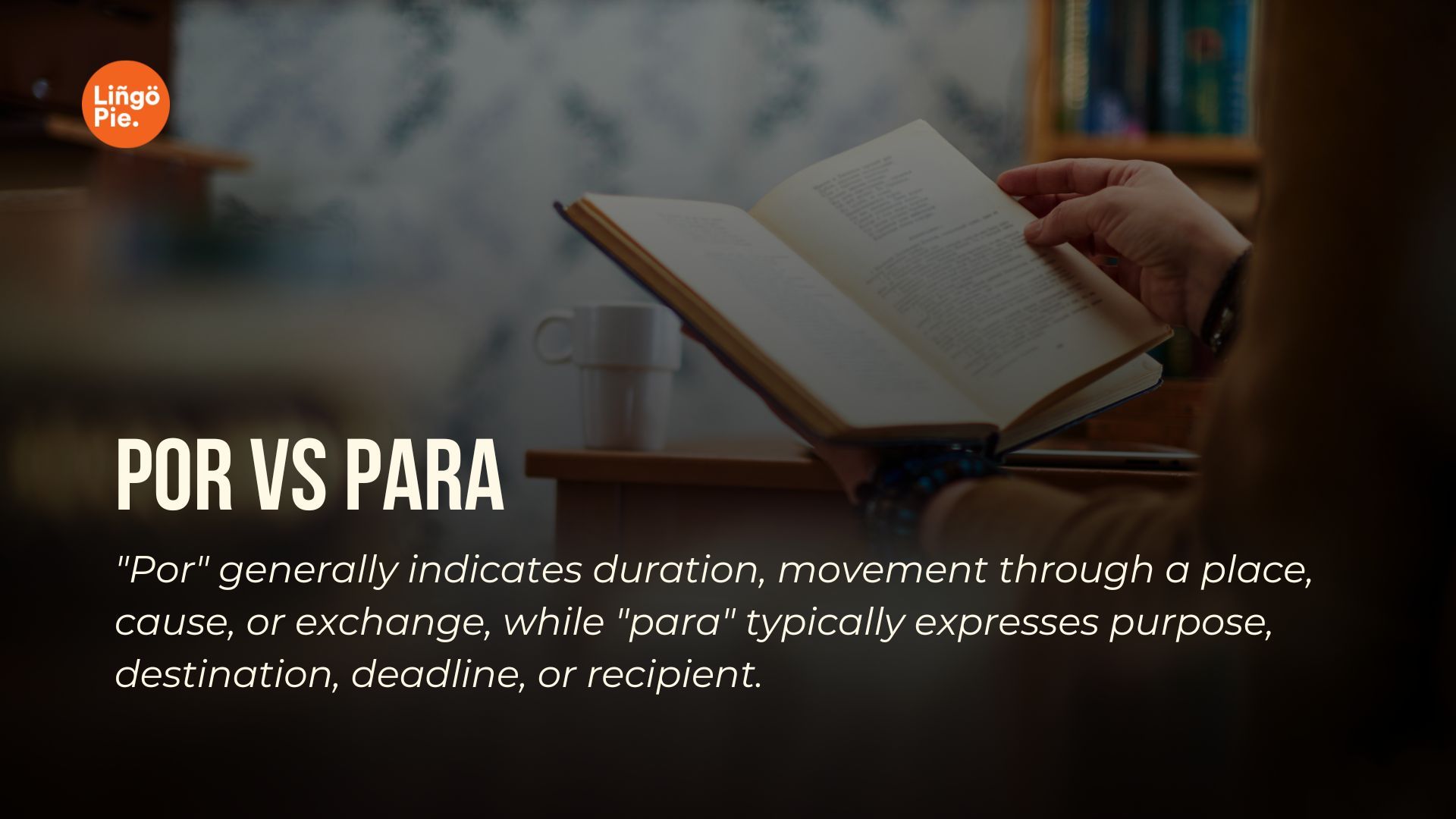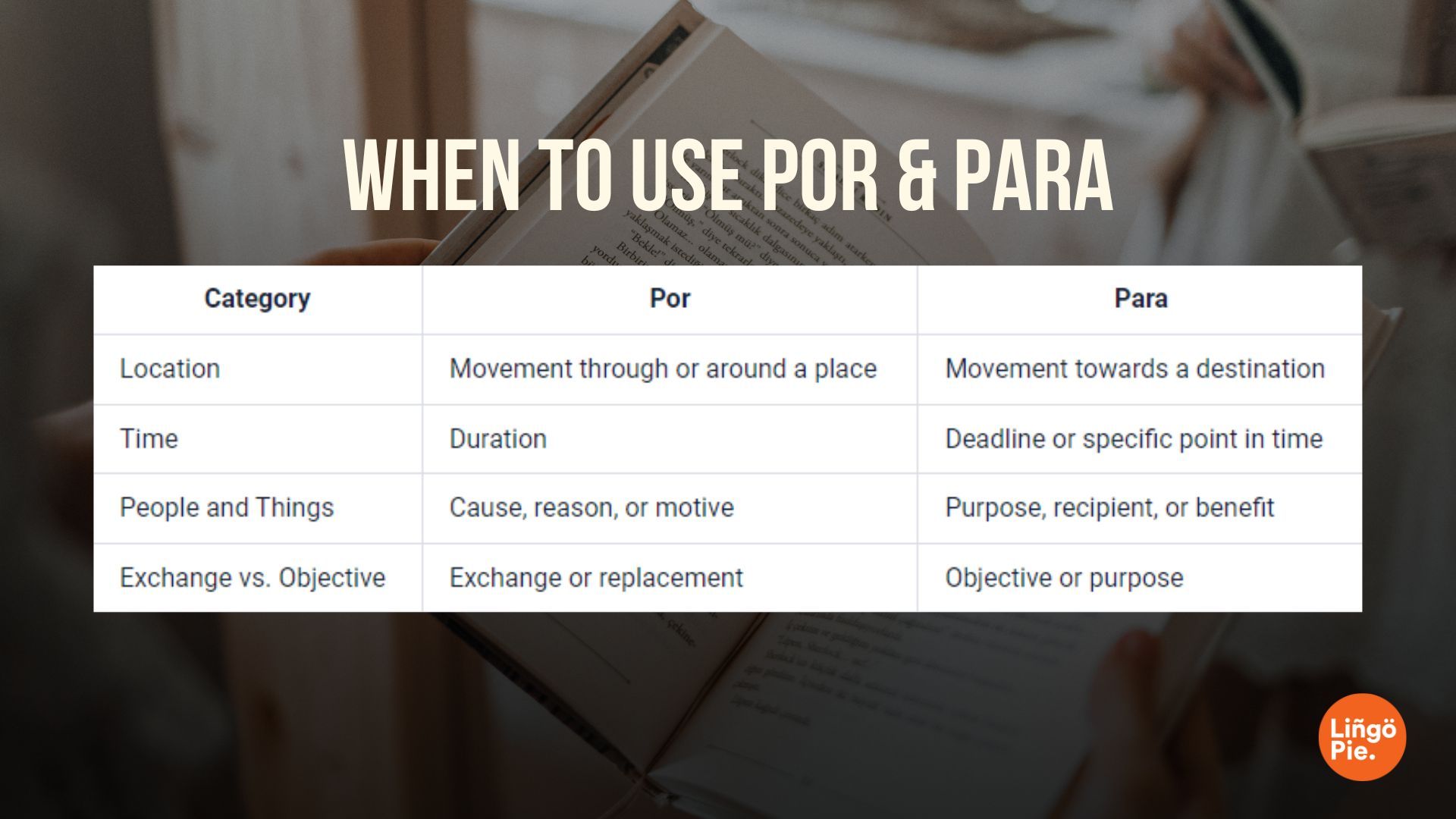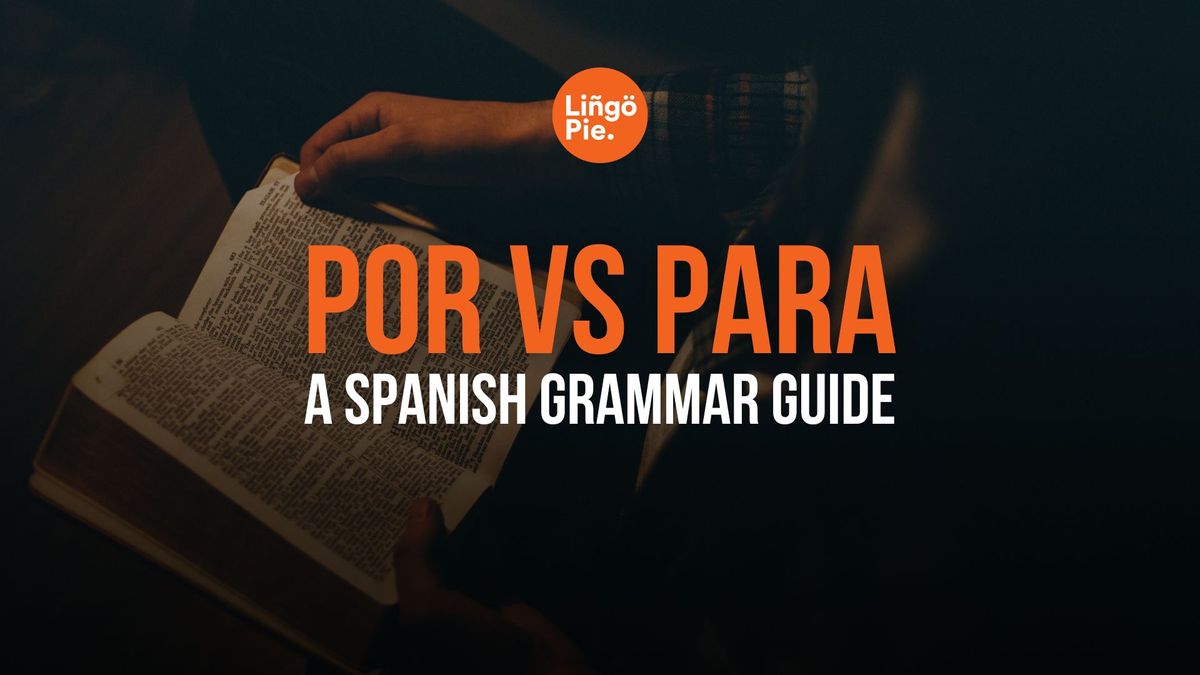If you're just starting your Spanish journey, you've probably already stumbled upon the infamous duo: Por Vs Para. These two little words might seem innocent enough, but trust me, they've caused more headaches for Spanish learners than a night of too many cervezas.
Even as someone who eventually became comfortable chatting away in Spanish, I still remember the heart-stopping moments when I'd freeze mid-sentence, desperately trying to decide whether to use por or para.
And so to help you get started, I made this ultimate cheat sheet to rescue you from the por vs para predicament. We're going to break down these tricky prepositions in a way that even total Spanish rookies can understand. No more panicked pauses or confused looks from your Spanish-speaking friends!
By the way, if you want to learn Spanish through TV and movies, my top recommendation for language learners is Lingopie. Find out more and try out the binge-learning method for FREE.

Why Is Por vs Para Challenging For Spanish Learners?
To understand why "por" and "para" can be tricky for Spanish learners, let's start with a couple of example sentences:
- "Voy a la tienda por pan." (I'm going to the store for bread.)
- "Estudio español para viajar a México." (I study Spanish to travel to Mexico.)
Both sentences use prepositions that could be translated as "for" in English, but they use different words in Spanish: “por” in the first sentence and “para” in the second. This subtle difference highlights why these prepositions can be challenging for Spanish learners.
The difficulty often arises because English doesn't always make the same distinctions that Spanish does with these prepositions. When learning Spanish, we're typically introduced to "por" and "para" as meaning "for" or "to," but this simplification doesn't capture their full range of uses.

In reality, "por" and "para" each cover a variety of meanings:
- Por can express: through, by, because of, during, per, and in some cases, for.
- Para can indicate: in order to, by (for deadlines), for the purpose of, and in some instances, for.
Specifically, para refers to the recipient or purpose of an action, while por indicates the agent who performs the action.
This broad spectrum of meanings contributes to the confusion many learners experience. It's not just about memorizing two words for "for" – it's about understanding when to use each one based on the specific context and intended meaning.
Another challenge is that choosing between "por" and "para" can sometimes subtly alter the meaning of a sentence. For instance:
- "Trabajo por dinero." (I work for money - emphasizing the motive)
- "Trabajo para ganar dinero." (I work to earn money - emphasizing the purpose)
While these sentences might seem similar in English, they convey slightly different nuances in Spanish.
The good news is that by focusing on a few key distinctions and practicing with various contexts, learners can significantly improve their understanding and use of “por” and “para.” In the following sections, we’ll explore these distinctions in more detail, providing clear guidelines and examples to help you navigate these tricky prepositions with greater confidence.

When To Use Por And Para
Understanding when to use "por" and "para" can significantly improve your Spanish. Let's break it down into three key areas: location, time, and people/things. This approach will help you grasp the nuances between these tricky prepositions.
Location: Movement vs. Destination
Think of "por" as the journey and "para" as the destination. When using "por" for location, you're describing movement through or around a place:
- "Caminamos por el parque" (We walked through the park)
- "El gato corre por la casa" (The cat runs around the house)
"Para," on the other hand, indicates movement towards a specific destination:
- "Vamos para la playa" (We're going to the beach)
- "El tren sale para Madrid" (The train leaves for Madrid)
Time: Duration vs. Deadline
With time expressions, "por" generally indicates duration, while "para" points to a deadline or specific point in time. Generally, you should use "por" to express a period of time:
- "Trabajé por tres horas" (I worked for three hours)
- "Viviremos en España por un año" (We'll live in Spain for a year)
- “Estudio por la tarde” (I study in the afternoon)
- “Trabajo por la noche” (I work at night)
Use "para" when referring to a deadline or specific time:
- "Necesito el informe para mañana" (I need the report by tomorrow)
- "La fiesta es para las ocho" (The party is at eight o'clock)
People and Things: Cause vs. Purpose
This is where "por" and "para" can get a bit trickier, but remember: "por" often indicates a cause or reason, while "para" suggests a purpose or recipient. Remember, always use "por" to express cause, motive, or exchange:
- "Lo hice por ti" (I did it because of you)
- "Pagué 20 euros por el libro" (I paid 20 euros for the book)
Use "para" to indicate purpose, recipient, or benefit:
- "Compré flores para mi madre" (I bought flowers for my mother)
- "Estudio para aprobar el examen" (I study to pass the exam)
- “Este regalo es para ti” (This gift is for you)
By keeping these distinctions in mind, you'll be better equipped to choose between "por" and "para" in various contexts.
Exchange vs. Objective
This final distinction helps clarify when to use "por" and "para" in situations involving transactions or goals. Generally, you should use "por" for exchanges or replacements:
- "Gracias por tu ayuda" (Thank you for your help)
- "Cambié mi bicicleta por un ordenador" (I exchanged my bicycle for a computer)
In these cases, "por" indicates a swap or an exchange of one thing for another.
Use "para" when expressing an objective or purpose:
- "Ahorro dinero para comprar una casa" (I'm saving money to buy a house)
- "Estudio español para viajar por Sudamérica" (I study Spanish to travel through South America)
Here, "para" points towards a goal or intended outcome. However, do note that you might use both "por" and "para" in the same sentence to express different ideas:
- "Yo trabajo por dinero y para aprender cosas nuevas." (I work for money and to learn new things.)
In this example, "por dinero" indicates the exchange (work for money), while "para aprender" expresses the objective.
- "Yo pago por la comida, y tú compras las cervezas para la fiesta." (I'll pay for the food, and you buy the beer for the party.)
Here, "pago por la comida" shows the exchange of money for food, while "para la fiesta" indicates the purpose of buying the beer.
Common Spanish Expressions with Por and Para
Understanding the difference between "por" and "para" becomes clearer when we examine how they're used in everyday phrases. Let's start by looking at a few key examples that highlight the distinct meanings these prepositions can convey:
- "Por qué" versus "para qué" "Por qué" typically asks about a reason or cause, while "para qué" inquires about a purpose or goal.
- "Por la mañana" versus "para la mañana" "Por la mañana" means "during the morning," while "para la mañana" suggests "by morning" or "for the morning."
- "Por el parque" versus "para el parque" "Por el parque" indicates movement through the park, while "para el parque" suggests movement towards the park.
These examples demonstrate how "por" often relates to reasons, duration, or movement through something, while "para" frequently indicates goals, deadlines, or destinations.
Now, let's explore some common Spanish expressions that use these prepositions. Familiarizing yourself with these phrases will help you use "por" and "para" more confidently in everyday conversations:
| English | Spanish |
|---|---|
| For example | Por ejemplo |
| For now | Por ahora |
| For sale | En venta / Se vende |
| For rent | En alquiler / Se alquila |
| To be about to (do something) | Estar por (hacer algo) |
| In my opinion | Para mí |
| Step by step | Paso a paso |
| For no reason | Por nada |
| It's up to you | Es por ti |
| To be thankful for | Estar agradecido por |
| In order to | Para que |
| On behalf of | Por parte de |
| Once and for all | De una vez por todas |
| For good | Para siempre |
| By chance | Por casualidad |
Remember, these expressions are commonly used in everyday Spanish conversations. Practicing and incorporating them into your speech will significantly enhance your fluency and help you sound more like a native speaker.
Mastering Por vs Para Quickly
While understanding the rules governing "por" and "para" is crucial, truly mastering these prepositions requires more than just memorization. The key to quick and effective learning lies in immersion and consistent exposure to authentic Spanish. Here are some strategies to help you rapidly improve your grasp of "por" and "para":
Create a Flashcard Deck
Develop a personalized flashcard deck focusing on "por" and "para" usage. Include common phrases, idiomatic expressions, and example sentences that highlight the distinctions between these prepositions. This method allows you to review and reinforce your understanding regularly.
Use Language Learning Apps
Take advantage of language learning apps that incorporate spaced repetition algorithms. These apps adapt to your learning pace, presenting "por" and "para" examples at optimal intervals to enhance retention and recall.
Immerse Yourself in Authentic Spanish
To truly train your ear and internalize the distinctions between "por" and "para", nothing beats exposure to native Spanish content. One effective method is to watch Spanish movies and TV shows using language-learning platforms like Lingopie. This approach allows you to see and hear how native speakers naturally use these prepositions in various contexts.
- 13 Best Spanish Movies on Netflix to Learn Spanish
- 21 Best Songs to Learn Spanish with Lingopie Music
- 7 Best Spanish Comedy Shows to Learn the Spanish Language
By watching content on such platforms, you'll encounter "por" and "para" in real-life situations, helping you understand their usage beyond textbook examples. You'll pick up on subtle nuances and idiomatic expressions that might not be covered in traditional grammar lessons.
Remember, mastering "por" and "para" is a gradual process. Be patient with yourself and celebrate small victories as you progress. With consistent practice and exposure to authentic Spanish, you'll find yourself using these prepositions more confidently and naturally in no time.
Mastering Por vs Para With Lingopie
As we've explored throughout this article, understanding the nuances between "por" and "para" is crucial for Spanish learners. We've covered various contexts where "por" and "para" are used, from expressions like "por la mañana" and "para mañana," to phrases such as "por qué" and "para qué." We've seen how "por" refers to duration (like "por dos horas") and "para" often indicates a final destination or purpose.
To truly master "por vs para," immerse yourself in the language. Watch Spanish movies, listen to Spanish music, and engage in conversations with native speakers. Pay attention to how they use these prepositions in context, whether it's "por teléfono," "para llegar a Madrid," or "por supuesto."
For a comprehensive and engaging way to improve your Spanish skills, including mastering "por" and "para," try Lingopie. This platform offers a wide range of Spanish content that will help you see these prepositions in action, from casual conversations to more formal contexts. You'll hear phrases like "por aquí," "para mí," and "por eso" used naturally, helping you internalize their correct usage.
Give Lingopie a try now!
FAQ
When should I use “por” instead of “para”?
Use “por” when referring to reasons or causes, such as “because of” or “due to.” It's also used to indicate movement through a place, duration of time, and means of communication or transportation. For example:
- Cause/Reason: “Lo hice por ti.” (I did it because of you.)
- Movement: “Caminamos por el parque.” (We walked through the park.)
- Duration: “Estudié por dos horas.” (I studied for two hours.)
- Means: “Hablamos por teléfono.” (We spoke by phone.)
When should I use “para” instead of “por”?
- Use “para” to indicate purpose, destination, or a recipient. It often translates to “in order to,” “for the purpose of,” or “intended for.” Examples include:
- Purpose: “Estudio para aprender español.” (I study in order to learn Spanish.)
- Destination: “Salgo para Madrid.” (I’m leaving for Madrid.)
- Recipient: “Este regalo es para ti.” (This gift is for you.)
Can “por” and “para” be used interchangeably?
No, “por” and “para” are not interchangeable. They have distinct meanings and uses. Using one in place of the other can change the meaning of a sentence or make it grammatically incorrect. Understanding the context and purpose of what you're expressing is key to choosing the right preposition.
Is “por” used for expressing gratitude?
Yes, “por” is commonly used to express gratitude. For example: “Gracias por tu ayuda.” (Thank you for your help.)









